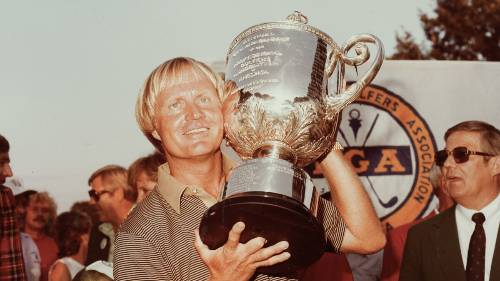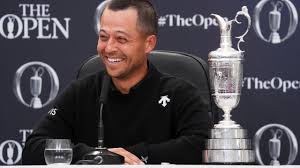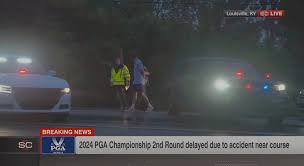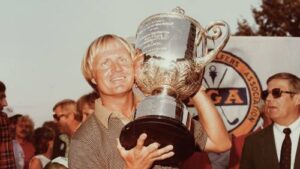
A Workingman’s History of Oak Hill Country Club’s East Course
—by Jay Flemma, Golf News Net—
PITTSFORD, NY – It was cold, grey, windy, and rainy Saturday in Rochester for the third round of the 105th PGA Championship. Indeed, the entire week at Oak Hill Country Club has been blustery with wind whistling through the leaves of the oaks and sycamores and stately elms, while the branches wave briskly like Midwestern wheatfields.
Metaphorically they are winds of change, but fair winds, promising fine sailing into the future. After years of intervening architects sacrificed Donald’s Ross’s architectural strategies for vapid, center-line, penal design tenets, the movement back to harmony that is the soul of this Second Golden Age of Golf Course Architecture finally has embraced Oak Hill.
It wasn’t always this way. This is the 7th major. Championship conducted at Oak Hill: three U.S. Opens (1956, 1968, and 1989) and three PGAs (1980, 2003, and 2013). It also hosted an unforgettable Ryder Cup in 1995, (dubbed “Choke Hill), and the 1949 U.S. Amateur.
Oak Hill Country Club dates back to 1901. It was just a 9-holer then, near edge of Genesee River, but it was prime land, and in 1922, George Eastman of Eastman Kodak and the University of Rochester wanted to extend their campuses. So, the club traded their 98 acres by the river for the 350 acres in Pittsford, where their two courses, East and West, are located now. Donald Ross insisted on having approval on the site, and upon granting it, the deal was closed, and Ross went to work. He walked the property ceaselessly, using the long ridges for green sites and routing holes treacherously close to Allen’s Creek.
After the ’49 Amateur where Charkes Coe won the 36-hole final by a still record margin of 11 and 10, Robert Trent Jones, Sr. was brought in to sharpen the East Course’s claws and fangs in preparation for the 1956 Open. As he did at Oakland Hills in 1951, Jones wasp-waisted the fairways and pinched them further in the landing zone with bracketing bunkers. (The new restoration has erased such inching and moved all the bunkers further to the wings, but also turned them perpendicular to the line of play, creating strategic angles.)
At the same time, an amateur arborist got himself elected greens chairman anointed himself a Johnny Appleseed.
Don Quixote is more like.
We won’t print his name so as not to “honor” his nearly ruining Oak Hills conditioning and strategic design, but he wrote to pretty much every country and had them send him acorns of their trees.
Nothing like threatening native species with invasive ones.
Any he planted these acorns – according to Golf Digest over 100,000 of them.
Thanks for nothing, genius.
One thing Jones didn’t touch was Ross’s shaggy greenside hummocks guarding the 17th green, and it was those hummocks that denied Ben Hogan a record fifth U.S. Open title. Coming down the stretch and tied with dr. Cary Middlecoff, (who gave up dentistry to play professional golf), Hogan failed to get up and down from the mounds, and Middlecoff claimed his third and final major championship.
1968 – SUPER MEX ARRIVES

Oak Hill’s East Course remained roughly the same when the pros returned to contest the 1968 U.S. Open. It was a tournament that would prove a watershed in the course’s architectural history nonetheless.
Looking back now over 50 years later, Lee Trevino has become a beloved icon and ambassador of golf. But in ’68 he was green, grateful, and gregarious. The players called him “the Jumping Bean” for his hyperactivity and mile-a-minute banter. He hadn’t yet won a PGA Tour event. And he was still a new face and unknown to most players except Jack Nicklaus and Ray Floyd.
Years earlier, Floyd traveled to Texas and battled Trevino for three days at dusty, flat Horizon Hills, in the vast tumbleweeds of Texas, in what is still to this day one of the most legendary one-on-one golf matches in history. That was before Trevino was on the Tour and was, instead, hustling in money games. Floyd eon by one stroke, and when they asked him for a rematch he politely declined.
“I’m going back to the Tour. It’s easier pickings out there!” he admitted.
But by ’68 not only was Trevino threatening to win, (he placed second in the two events prior to Oak Hill), but Jack Nicklaus had told him privately, “you can beat anybody.”
“Heading into Rochester I felt I was at the top of my game,” Trevino wrote in 1969, reflecting on his victory. “As I passed through Utica, New York, I saw some kids playing a baseball game n a park, so I stopped, got myself a Coke and a hamburger, and watched the whole game. I was in no hurry, I stopped…just to enjoy a ball game or the scenery.”
Trevino stayed with a family that had specifically requested him as their guest. As he was new to the Tour and from Mexico, they hoped to help ease the cost of his expenses. They also had five young children and wanted someone who would entertain them.
Good choice with Trevino.
“I always had someone to talk to,” Trevino recalled. “The father was a former pitch in the Yankees farm system. The wife spent the whole week walking the house wearing nothing but a black bathing suit. I couldn’t help looking at her!”
Trevino claimed that everything went right that week, and it did. Armed with a putter that Dennis Lavender, the head pro at Cedar Crest gave him – “I’ll fix you up with a putter you’ll win the Open with,” Lavender boasted and he did – Trevino went out and set a U.S. Open record carding four rounds in the 60s. He also tied Jack Nicklaus’s aggregate U.S. Open scoring record, at that tie 275. (Nicklaus reclaimed it at Baltusrol in 1980 with 272. Rory McIlroy subsequently shattered that with 268 at Congressional in 2011.)
In rounds one and two, “I was splitting every fairway with tee shots and chipping and putting were strong. My game was under control,” Trevino stated.
In round three he was in the final pairing with the leader Bert Yancey. Trevino picked up a shot that Saturday, but nevertheless, as Championship Sunday dawned, the smart money was on Yancey, not the Jumping Bean. After all, Yancey was a military man educated at West Point. Tall and blond, Yancey was a cross between Robert Redford’s good looks (think the guy they send ot to kill James Bond…) and Gene Littler’s machine-like golf swing.
“Everyone thought I’d shoot 80,” Trevino explained, and after his first tee snot it looked that way. “I hit a low screamer that barely made the fairway.”
But Trevino righted the ship. Wearing what became a Sunday tradition for him – he sported a red shirt, black pants, and red socks, “my payday colors” he called them – Trevino went on a back nine tear, birdieing 11, 12, and 13, while Yancey faltered, playing the stretch 2-over.
“That blew it open,” Trevino wrote. “I went to 14 with a five shot lead.”
As he stood over his final approach shot to the 72nd green, he turned to Kevin Quinn, a young local kid who was his caddie and asked what he should hit in. The kid responded 5-iron.
“Man, my caddie’s choking worse than I am,” he jibed, and then hit an 8-iron. After getting up and down from the rough, he had his first professional victory – the U.S. Open. He would claim five more majors in his illustrious career.
“Five policemen escorted me to the clubhouse. I haven’t had that much attention from cops since I backfired my 1949 ford on the North Central Expressway when I was 15,” he joked.
As expected, things devolved into the typical Trevino comedy routine; he should have had his own lounge act in Vegas, he delivery and timing being so smooth. Here’s a few more Trevino-isms from his recollections:
—after they handed him the trophy and told him he was the first player from Mexico to win a major, Trevino responded, “I used to be a Mexican, but I’m makin’ money now, so I think I’m gonna be a Spaniard;”
—then they asked what he’ll do with the money he won. First, he said, “my wife will be calling if it hasn’t arrived by Wednesday,” and then he remarked, “I may buy the Alamo and give it back to Mexico;”
—folks at the alamo heard about that joke, and invited Trevino for a tour. After the tour finished, he said, “Well, I’m not gonna buy tbis place. It doesn’t have indoor plumbing;” and
—years later Trevino returned Oak Hill when they dedicated a tree to him. He said, “with my luck that’ll be the only one the dogs use.”
Still, that still doesn’t top the time at the 1970 Open Championship at St. Andrews when Trevino walked up to Prince Charles (Now King Charles III) and asked, “You ever shake hands with a Mexican before?”
That tournament was also the advent of “Lee’s Fleas,” his rabid fans that urged him to “Whip the Gringos!” He immediately appealed to the everyday golf fan: this tiny little guy, smile as wide as the Rio Grande and a matching, never-ending, mile-a-minute good humor. With his choppy public course swing, caddie hustler stance, and disarming charm his legend grew with each unlikely escapade. But the groundwork for his Hall of Fame career was laid at Oak Hill, both on the course and off.
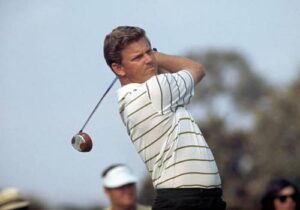
JACK NICKLAUS, ONCE MORE WITH FEELING
Oak Hill has an illustrious history. Sadly, the 1970s and ‘80s didn’t help. Yes, Jack Nicklaus added to his legend winning the 1980 PGA by a then record seven shots, and claiming his second major of the season, along with the U.S. Open. But that PGA Championship is also remembered for something more akin to U.S. Opens – chronic complaining about the golf course. In the 1970s, George Fazio and his nephew Tom were brought in to toughen the East Course. Trevino carding four rounds in the ‘70s was an insult to the members and the USGA, which didn’t like being known for low scores.
The Fazios created four holes that were completely incongruous and roundly disliked. Greens did not acceot well hit shots, Golfer after golfer panned the new holes, and even Nicklaus, normally so gracious couldn’t find anything to say about the changes other than a milquetoast observation that everyone had to play the same course, and that perhaps Oak Hill should be described as having 14 Donald Ross hole and four George Fazio holes.
But it was Tom Weiskopf who talked the talk and then walked the walk. Weiskopf was and maybe still is a legendary complainer, but he was absolutely right in his criticism and more so in his solution.
“I’m going to start an organization called the Classic Golf Course Preservation Society. Members get to carry loaded shotguns in case they see anybody touching a Donald Ross Golf Course,” he fumed.
But he put his money where his mouth is. The Donald Ross Society created, and still, six decades later it is the gold standard in golf architectural circles in protecting, preserving and promoting Golden age architecture. Time after time they prove both resourceful and useful tools for any Ross course seeking advice on its history or guidance on its architectural way forward.
The needed changes still had not happened at Oak Hill when the Open returned in 1989. Again the USGA narrowed the fairways, pinched the landing zones, and grew the rough to Serengeti proportions, and again we got a leaderboard filled with flotsam, jetson, (and players inconvenient to selling newspapers and magazines). Curtis Strange may have pulled off the ultra-rare feat of winning back-to-back U.S. Opens, but it seems like all the premiere players might have gone fishing that week at Oak Hill. Strange’s one stroke victory saved us from having to endure an 18-hole Monday finish against Ian Woosnam, Chip Beck and Mark McCumber. And right behind them was the Murderer’s Row of Brian Klaar, Scott Simpson, and Jumbo Ozaki.
Similarly, the 2003 PGA, which was set up to resemble a U.S. Open, saw another leaderboard devoid of marquee names. In fact, Not since 1969 had we had a goofier collection of major champions than 2003. The four winners of the majors in 2003 were Mike Weir, (who did little else in his professional career), Jim Furyk, (who is 1-for-8 on championship Sundays in majors when he’s been in the mix come the back nine), Ben Curtis, (who played his last seven holes 4-over, but still backed into the Open Championship title when Thomas Bjorn double bogeyed the 70th hole by leaving two shots in a greenside bunker), and…drum roll please…Shaun Micheel at the PGA at Oak Hill.
2013 could have been a repeat, but the 36 hours of rain softened the course, and Jason Dufner held off Jim Furyk.
But now, finally, after decades of having Ross’s design upended, thousands of trees came down.
“We wanted to protect the legacy of the trees,” said one greens committee member. But let me be clear in my response:
SCREW THE LEGACY OF THE TREES!!!
You can grow grass or you can grow trees, but you can’t have both. Sink a plaque instead or dedicate a bridge.
But finally Oak Hill got it right. We’re seeing that Oak Hill is not a bomber’s paradise with the trees removed. The bunkers, rough, and hills defend par admirably. So everyone can now celebrate Oak Hill’s resurgence. It may have been 60 years in the making, but hey, better late than never.


